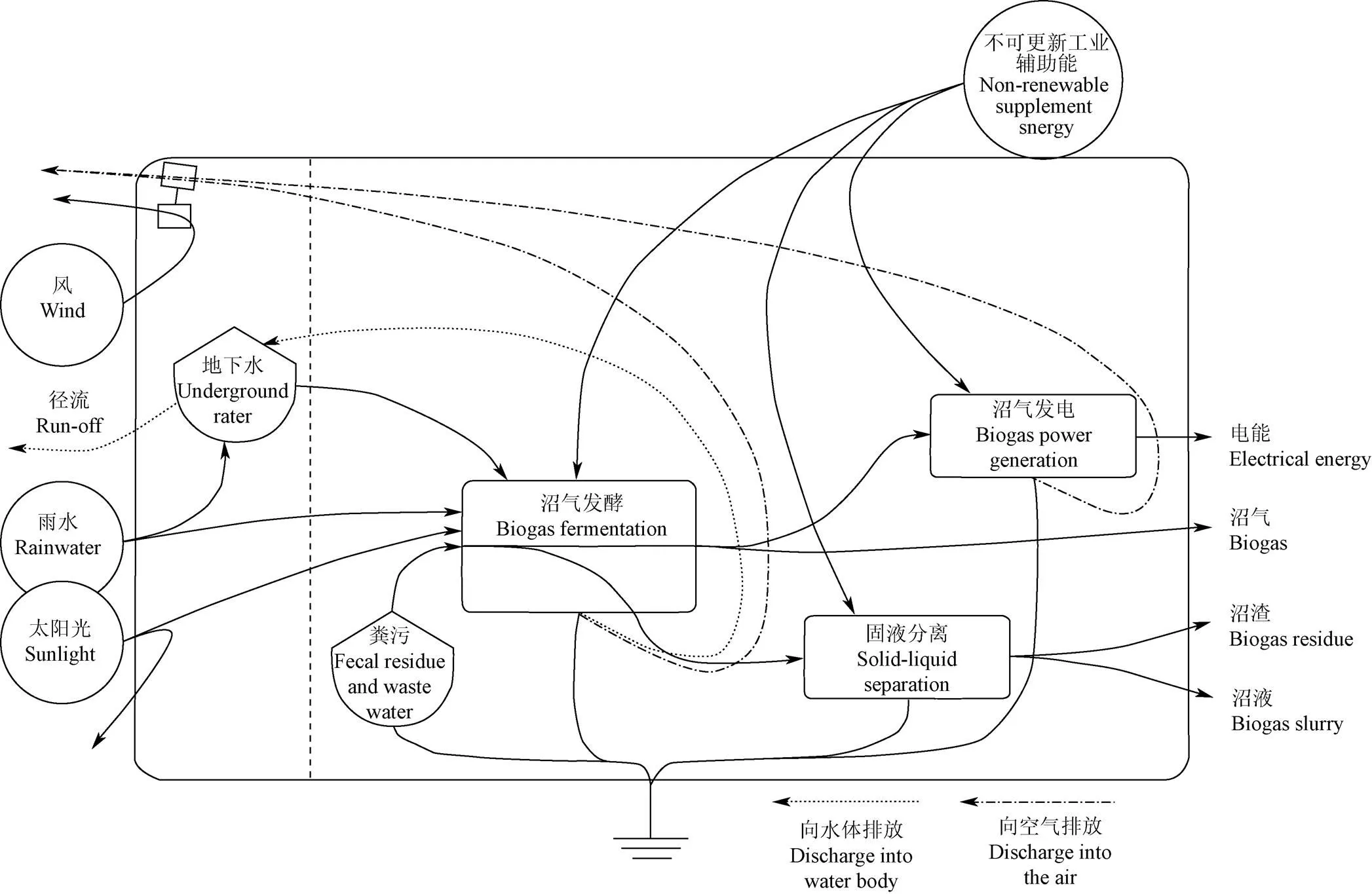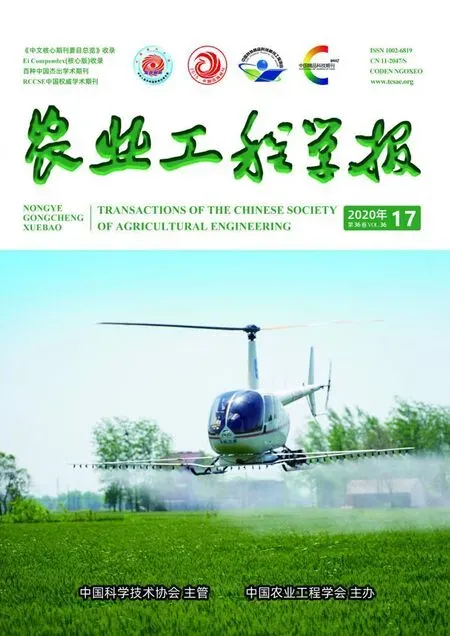基于能值分析的奶牛产业园区循环发展模式评价
董姗姗,隋 斌,赵立欣,孟海波,沈玉君,周海宾,丁京涛,程红胜
基于能值分析的奶牛产业园区循环发展模式评价
董姗姗1,2,隋 斌2※,赵立欣1,3,孟海波1,2,沈玉君1,2,周海宾1,2,丁京涛1,2,程红胜1,2
(1. 农业农村部规划设计研究院,北京 100125;2. 农业农村部资源循环利用技术与模式综合性重点实验室,北京 100125;3. 农业农村部废弃物能源化利用重点实验室,北京 100125)
以沼气工程为纽带的循环农业模式是降低农业产业园区废弃物污染、提高资源利用率的有效方式。该研究构建了适合园区规模的循环农业模式能值评价指标体系,以河北省某典型奶牛产业园区为案例,将园区现行的利用全混式厌氧反应技术(Continuous Stirred Tank Reactor,CSTR)的湿法单相厌氧消化沼气工程,与湿法两相耦合厌氧消化、干法序批式厌氧消化、干法连续式厌氧消化3种不同沼气工程模式进行对比,运用能值理论及计算方法对以沼气工程为纽带的农业产业园循环模式进行了评价,选择最适宜园区发展的沼气工程模式。结果表明,该园区能值投入率为17.57,能值产出率为0.41,环境负载率0.33,可持续发展指数1.23,以CSTR湿法单相厌氧消化沼气工程为纽带的循环农业模式整体效益优于其他3种模式。研究对其他园区的循环农业模式评价和以沼气工程为纽带的循环农业发展具有借鉴意义。
循环农业;能值分析;奶牛养殖;产业园区;资源化利用;沼气工程
0 引 言
近年来,随着中国奶业振兴和全国奶牛养殖规模不断扩大,2018年奶牛存栏量已达1 037.7万头[1],现代化、标准化和规模化的园区式牧场逐渐成为主流。奶牛养殖供给优质乳品、满足人们营养需求和促进经济发展的同时,也产生了大量的养殖粪污,对环境造成了较大的压力[2]。如何资源化利用养殖粪污、减少环境污染已成为国内外研究热点。
循环农业作为一种倡导最大限度提升资源的利用效率、多种途径循环可再生资源的农业可持续发展模式倍受关注[3-6]。将循环农业理念运用在奶牛养殖废弃物处理上也颇有成效,以沼气工程为纽带的种养结合循环模式是其中的典型模式之一,通过沼气工程处理养殖粪污,沼渣沼液还田利用,可将养殖业和种植业有机结合在一起,形成物质、能量循环利用的产业链,在减轻环境污染的同时,实现农业生态系统资源循环利用[7]。现行的沼气工程主要包括利用安装搅拌装置使发酵原料和微生物完全混合这全一混式厌氧反应技术(Continuous Stirred Tank Reactor,CSTR)的湿法单相厌氧消化、通过2个串联装置使酸化和甲烷化分别进行的湿法两相耦合厌氧消化、利用车库式反应器的干法序批式厌氧消化、利用立式-横推流式反应器的干法连续式厌氧消化共4种模式[8-11]。对于以沼气工程为纽带的种养结合循环模式,现有研究主要关注沼气工程发酵效率提升、三沼(沼气、沼渣、沼液)综合利用等方面,而从循环系统整体出发对模式资源利用程度和发展水平等进行效果评价的研究仍鲜有报道[12-13]。近年来,国内学者已建立了一些评价体系,其中涉及到的评估方法众多,如综合指数评价、经济效益评价、专家打分法等,但由于具体模式的内容和方法差异较大,评价指标选取较为多元,这类方法通常主观性较强,操作困难,可比性不强[14-16]。
能值分析理论和方法是由美国著名生态学家H. T. Odum于20世纪80年代创立的,这一方法是从系统能量流动的角度出发,引用太阳能值作为统一的单位,将系统中计量单位不同、不便于互相转化的各种物质、能量进行比较和分析,进而对系统中的自然资源消耗、人类参与程度等进行定量分析[17]。目前已广泛应用于自然生态系统、农业生态系统以及区域生态系统发展可持续性的分析、评价与比较中[18-20]。本研究以中国河北省具有典型代表性的某产业园区为案例,以“奶牛养殖—沼气工程”循环农业模式为研究对象,将湿法单相厌氧消化,湿法两相耦合厌氧消化、干法序批式厌氧消化、干法连续式厌氧消化这4种常见的沼气工程效果进行对比,对沼气工程为纽带的种养结合循环农业模式效果进行评估。本研究运用能值分析方法构建了评价指标体系,对园区内循环农业系统进行了深入分析,通过计算自然、人力等各种资源需求,综合考虑该园区的可持续发展性和生态经济效益,最终选择出最适宜园区发展的沼气工程模式,并提出下一步发展建议。基于本研究的数据基础及所构建的能值评价指标体系,其他同类型的产业园区也可进行类比分析,对产业园区中种植业与养殖业规模配比、沼气工程处理能力等重点参数进行评估,有针对性地获取相关发展建议,由此为以沼气工程为纽带的种养结合循环农业模式的推广提供科学依据。
1 研究区概况及方法
1.1 研究区概况
河北省某典型奶牛养殖产业园区占地面积2×105m2,研究区域年太阳辐射5 016~5 852 MJ/m2,年平均气温15 ℃,年平均降雨量558.5 mm。园区内年养殖奶牛5 500头,养殖面积6.05×104m2,建有日处理1 000 m3奶牛粪污的沼气工程一处,发酵工艺为CSTR,产生的沼气用于产热和发电以供给园区使用,沼渣用于生产有机肥,沼液作为种植业液态肥料施用,形成了农业废弃物多层次利用的循环农业系统。本研究以“奶牛养殖—CSTR湿法单相厌氧消化沼气工程”循环农业模式(模式Ⅰ)为研究对象,与同规模的湿法两相耦合厌氧消化(模式Ⅱ)、干法序批式厌氧消化(模式Ⅲ)、干法连续式厌氧消化(模式Ⅳ)3种沼气工程模式进行分析、比较和评价。
1.2 指标体系构建
对园区进行实地调研,从能值流动、资源利用、环境负载和经济发展4个方面入手,建立了园区的循环农业系统的评价体系[17,21-23]。通过对以沼气工程为纽带的种养结合循环系统涉及的不同资源及环节进行划分,将能值流量指标分为可更新环境资源(Renewable Natural Resources,)、不可更新环境资源(Non-renewable Natural Resources,)、可更新有机能(Renewable Organic Energy,1)、不可更新工业辅助能(Non-renewable Supplement Energy,)和系统总产出(Yield,)5个部分组成(图1)[17]。其中,太阳、风、雨水属于系统自身的环境资源,可更新有机能和不可更新工业辅助能属于人类对系统投入的经济购买能值。另外,在可更新有机能中,有一部分资源作为生产过程中的中间产物,是可在经进一步处理后在系统中重复利用的。

图1 产业园区沼气工程模式系统能流
结合园区奶牛养殖耦合沼气工程的特点,本研究主要选用能值投入率(Emergy Input Ratio, EIR)、能值产出率(Emergy Yield Ratio, EYR)和能值自给率(Emergy Self-sufficiency Ratio, ESR)对园区资源循环利用情况进行分析,采用可更新能值比率(Renewable Emergy Ratio,RER)、环境贡献率(Emergy Contribution Ratio, ECR)和环境负载率(Emergy Loading Ratio, ELR)度量资源利用对环境的影响,同时参考综合指数评价方法,从中选取能值可持续指标(Emergy Sustainable Index, ESI)对该园区的循环农业发展进行综合评价。通过上述3类资源、环境、可持续发展的指标,构建了产业园区循环农业的综合评价指标体系(表1)。

表1 2018年产业园区循环系统能值评价体系
1.3 研究方法及数据处理
研究中湿法单相厌氧消化模式的原始数据都来自2018年对研究区的实地调研和资料收集,以园区现有沼气工程为纽带,以完整生产年度为期进行数据记录,以河北省统计局、河北省气象局等机构记录为基准对自然资源数据进行收集(表2)。研究中涉及的原始数据计算方法参考Odum、陈阜等学者的研究[21-24]。考虑到初级自然资源的能值转换率在不同地区变化不大,选择Odum研究团队的能值转换率参数,对太阳光能、风能、雨水化学能等环境资源进行测算。化肥、农药等经济系统资源的贡献,采用《中国统计年鉴》、《中国农村统计年鉴》及河北省统计局公布的2018年相关数据进行测算[25-28]。湿法两相耦合厌氧消化、干法序批式厌氧消化、干法连续式厌氧消化3种模式的数据通过实地调研和已发表文献中的相关工艺参数进行模拟测算后获得[17,21-24]。
所有数据均用Excel整理和统计。
2 结果与分析
2.1 能值投入产出分析
4种不同沼气工程模式的能值数据见表2。总能值投入量由可更新环境资源能值、不可更新环境资源能值、可更新有机能值和不可更新工业辅助能值组成,统计后的能值流分析结果见表3。
注:模式I~IV分别为湿法单相厌氧消化、湿法两相耦合厌氧消化、干法序批式厌氧消化、干法连续式厌氧消化,下同。
Note: Mode I-IV is wet single phase anaerobic digestionbasedoncontinuous stirred tank reactor anaerobic fermentation, wet two-phase couplinganaerobic digestion, dry sequential batch anaerobic digestion and dry continuous anaerobic digestion, respectively. Same below.
由表3可知,模式Ⅰ中的总能值投入量为1.69×1018sej,其中可更新环境资源能值为3.87×1016sej,不可更新环境资源能值为5.24×1016sej,环境资源能值投入占总能值投入的5.39%;可更新有机能值为3.70×1017sej,不可更新工业辅助能值为1.23×1018sej,外界资源能值投入占主导地位,占总能值投入的94.62%,其中原材料和能源的投入是主要部分;能值产出量为6.55×1017sej,玉米、牛奶、沼气、有机肥等产品能值为4.18×1017sej,占产出能值的63.77%;沼渣、沼液等再利用资源的能值为2.37×1017sej,占产出能值的36.23%。与模式Ⅰ相似,模式Ⅱ、Ⅲ、Ⅳ均以外界资源投入为主。模式Ⅱ中总能值投入量为2.93×1018sej,环境资源能值投入占总能值投入的3.11%;能值产出量为2.67×1017sej,牛奶、沼气、有机肥等产品能值为2.36×1017sej,占产出能值的88.18%;沼渣、沼液等再利用资源的能值为3.16×1016sej,占产出能值的11.82%。模式中Ⅲ总能值投入量为3.00×1018sej,环境资源能值投入占总能值投入的3.04%;能值产出量为5.39×1017sej,牛奶、沼气、有机肥等产品能值为2.78×1017sej,占产出能值的51.67%;沼渣这一再利用资源的能值为2.60×1017sej,占产出能值的48.33%。模式Ⅳ中总能值投入量为3.15×1018sej,环境资源能值投入占总能值投入的2.89%;能值产出量为4.04×1017sej,牛奶、沼气、有机肥等产品能值为2.69×1017sej,占产出能值的66.51%;沼渣等再利用资源的能值为1.35×1017sej,占产出能值的33.49%。
对比4种不同沼气工程模式可以发现,相比其他3种模式,模式Ⅰ中系统总投入能值1.69×1018sej更低,而能值产出量6.55×1017sej更高,系统的能值产出量占总投入能值的38.75%,如能提高系统的能值产出量,则能促进系统的进一步发展。

表3 4种沼气工程模式能值流比较
2.2 环境负载分析
根据能值投入产出分析,进一步计算园区内各综合指标值,具体见表4。其中,模式Ⅰ、模式Ⅱ、模式Ⅲ和模式Ⅳ的可更新能值比均较低,分别为0.02、0.01、0.01和0.01,说明以这4种沼气工程为纽带的循环系统仍对不可更新能值的依赖较高,其原因主要是沼气工程运行过程中产生的大量能值被消耗。

表4 能值评价指标计算值
环境贡献率反映了系统中自然环境对农业经济发展的贡献,而环境负载率则评价了系统对周围环境造成的压力,如表4所示,模式Ⅰ、模式Ⅱ、模式Ⅲ和模式Ⅳ所生产的ECR值分别为0.05、0.03、0.03和0.03,ELR值分别为0.33、0.25、0.27和0.31,其来源主要是因为养殖及生产过程中大量水、电、肥的投入,是中国农业ELR平均水平(2.72)[29]的9.19%~12.13%,说明以这4种沼气工程为纽带的循环系统对周围环境造成了较小的压力。
2.3 资源利用分析
能值投入率衡量了系统的资源投入情况,能值产出率衡量了系统本身的资源利用能力对经济系统的贡献,EYR越高则系统的资源利用效率越高[29]。如表4所示,模式Ⅰ、模式Ⅱ、模式Ⅲ和模式Ⅳ所生产的EIR值分别为17.57、31.28、31.92和33.63,整体高于发达国家7.00的标准[30],说明园区的资源投入程度较高,能够吸引投资者,经济发展有良好的走势[2];EYR值分别为0.41、0.09、0.19和0.13,对于4种不同沼气工程模式,模式Ⅰ对于本地资源的依赖度最低,其次是模式Ⅱ和模式Ⅳ,同时,模式Ⅰ对资源的利用效率最高,其次是模式Ⅲ和模式Ⅳ。
能值自给率反映了以沼气工程为纽带的循环系统中各组分对于该沼气循环系统的支撑能力[13]。对于4种不同沼气工程模式,模式Ⅰ及模式Ⅱ中系统的循环特征主要表现在沼渣有机肥和沼液再利用上,模式Ⅲ和模式Ⅳ中系统的循环特征主要表现在沼渣有机肥再利用上。如表4所示,模式Ⅰ的ESR值为0.39,模式Ⅱ、模式Ⅲ和模式Ⅳ所生产的ESR值分别为0.09、0.18和0.13,均低于模式Ⅰ,说明系统中本地环境资源的贡献更低,外部能量需求度相较于模式Ⅰ更高。
能值可持续指标通过能值产出率和环境负载率的比值来反映系统可持续性的高低,可持续性高则表明系统在维持资源供给的同时,也可降低对环境的潜在影响,实现污染降级[31]。对于4种不同沼气工程模式,ESI值分别为1.23、0.37、0.68和0.43,其中模式Ⅰ的ESI值均大于1,说明经济系统具有活力和发展潜力,其可持续性最好;而模式Ⅱ、模式Ⅲ和模式Ⅳ的ESI值小于1,表示现行系统仍属于消费型经济系统,可持续发展性能有待提高[32]。
3 结 论
本文以中国河北省具有典型代表性的某产业园区为例,根据该园区“奶牛养殖—沼气工程”的循环农业模式,构建了适合园区规模的循环农业模式能值评价指标体系,选择4种常见的沼气工程模式,以园区现行的利用全混式厌氧反应技术(Continuous Stirred Tank Reactor,CSTR)的湿法单相厌氧消化沼气工程为参照,与湿法两相耦合厌氧消化、干法序批式厌氧消化、干法连续式厌氧消化3种沼气工程模式进行对比,根据能值分析方法分析了园区内循环农业模式环境安全性、资源减量率及可持续发展度。结果表明,相对于其他3种沼气工程模式,CSTR湿法单相厌氧消化沼气工程更适合园区发展,通过CSTR湿法单相厌氧消化处理奶牛养殖废弃物,提升废弃物循环利用效率后,园区能值投入率为17.57,明显高于其他3种模式,达到了系统资源减量化目标;能值产出率为0.41,沼渣沼液等废弃物在系统内消耗占比高于其他3种模式,降低了系统的整体投入成本,提高了系统的生产效率;环境负载率0.33;可持续发展指数1.23,系统更具活力和发展潜力。
由于现行的多数种养结合循环模式、沼气工程生产流程存在一定的共性,本研究的数据基础及所构建的能值评价指标体系对其他产业园区的发展评价也有借鉴意义,可用于评估同等规模的循环模式,分析改进系统中种植与养殖规模配比、沼气工程处理能力等重要参数。但本研究也存在一定的欠缺,由于所选用的能值分析方法主要是基于系统循环过程中投入资源种类和数量进行计算及评价,当系统的投入或产出发生较大变化时,会影响量化计算结果,进而影响整体评价结果,如何对这一问题进行改进,使评价体系更具普遍适用性,是进一步研究的重要方向。
[1] 国家统计局农村社会经济调查司. 中国农村统计年鉴2019[M]. 北京:中国统计出版社,2019.
[2] 田宜水. 中国规模化养殖场畜禽粪便资源沼气生产潜力评价[J]. 农业工程学报,2012,28(8):230-234.
Tian Yishui. Potential assessment on biogas production by using livestock manure of large-scale farm in China[J]. Transactions of the Chinese Society of Agricultural Engineering (Transactions of the CSAE), 2012, 28(8): 230-234. (in Chinese with English abstract)
[3] 陈德敏,王文献. 循环农业:中国未来农业的发展模式[J]. 经济师,2002(11):8-9.
Chen Demin, Wang Wenxian. Circular agriculture: The development model of China's future agriculture[J]. China Economist, 2002(11): 8-9. (in Chinese with English abstract)
[4] 高旺盛,陈源泉,梁龙. 论发展循环农业的基本原理与技术体系[J]. 农业现代化研究,2007,28(6):731-734.
Gao Wangsheng, Chen Yuanquan, Liang Long. Basic principles and technology supporting for circular agriculture[J]. Development Research of Agricultural Modernization[J]. 2007, 28(6): 731-734. (in Chinese with English abstract)
[5] 周震峰. 循环农业的发展模式研究[J]. 农业现代化研究,2008(1):61-64.
Zhou Zhenfeng. Research on development model of circular agriculture[J]. Research of Agricultural Modernization, 2008(1): 61-64. (in Chinese with English abstract)
[6] 尹昌斌,周颖,刘利花. 我国循环农业发展理论与实践[J]. 中国生态农业学报,2013,21(1):47-53.
Yin Changbin, Zhou Ying, Liu Lihua. Theory and practice of recycle agriculture in China[J]. Chinese Journal of Eco-Agriculture, 2013, 21(1): 47-53. (in Chinese with English abstract)
[7] 赵立欣,孟海波,沈玉君,等. 中国北方平原地区种养循环农业现状调研与发展分析[J]. 农业工程学报,2017,33(18):1-10.
Zhao Lixin, Meng Haibo, Shen Yujun, et al. Investigation and development analysis of planting-breeding circulating agriculture ecosystem in northern plains in China[J]. Transactions of the Chinese Society of Agricultural Engineering (Transactions of the CSAE), 2017, 33(18): 1-10. (in Chinese with English abstract)
[8] 赵兰兰,冯晶,赵立欣,等. 全混式厌氧发酵反应器优化研究进展[J]. 中国沼气,2018,36(4):35-40.
Zhao Lanlan, Feng Jing, Zhao Lixin, et al. Research progress on optimization of completely mixed anaerobic fermentation reactor[J]. China Biogas, 2018, 36(4): 35-40. (in Chinese with English abstract)
[9] 张议心,赵立欣,冯晶,等. 干-湿联合两相厌氧发酵技术处理村镇固体废弃物研究进展[J]. 中国沼气,2018,36(6):72-78.
Zhang Yixin, Zhao Lixin, Feng Jing, et al. A review on dry-wet combined two-phase anaerobic digestion treating rural solid waste[J]. China Biogas, 2018, 36(6): 72-78. (in Chinese with English abstract)
[10] 于佳动,赵立欣,冯晶,等. 序批式秸秆牛粪混合厌氧干发酵影响因素研究[J]. 农业工程学报,2018,34(15):215-221.
Yu Jiadong, Zhao Lixin, Feng Jing, et al. Influence factors of batch dry anaerobic digestion for corn stalks-cow dung mixture[J]. Transactions of the Chinese Society of Agricultural Engineering (Transactions of the CSAE), 2018, 34(15): 215-221. (in Chinese with English abstract)
[11] 胡鑫,冯晶,赵立欣,等. 干法厌氧发酵反应器及过程控制技术研究进展[J]. 中国沼气,2018,36(2):68-75.
Hu Xin, Feng Jing, Zhao Lixin, et al. Research progress of dry anaerobic fermentation reactors and its process control technique[J]. China Biogas, 2018, 36(2): 68-75. (in Chinese with English abstract)
[12] 丁京涛,张朋月,华冠林,等. 北京大中型沼气工程冬季运行状况及发酵前后物料理化生物特性[J]. 农业工程学报,2018,34(23):213-220.
Ding Jingtao, Zhang Pengyue, Hua Guanlin, et al. Running status of large and medium scale biogas project and physical, chemical and biological characteristics of materials before and after fermentation in winter of Beijing[J]. Transactions of the Chinese Society of Agricultural Engineering (Transactions of the CSAE), 2018, 34(23): 213-220. (in Chinese with English abstract)
[13] 钟珍梅,黄勤楼,翁伯琦,等. 以沼气为纽带的种养结合循环农业系统能值分析[J]. 农业工程学报,2012,28(14):196-200.
Zhong Zhenmei, Huang Qinlou, Weng Boqi, et al. Energy analysis on planting-breeding circulating agriculture ecosystem linked by biogas[J]. Transactions of the Chinese Society of Agricultural Engineering (Transactions of the CSAE), 2012, 28(14): 196-200. (in Chinese with English abstract)
[14] 杨增玲,楚天舒,韩鲁佳,等. 秸秆饲料化集成技术模式及其区域适用性评价[J]. 农业工程学报,2013,29(23):186-193.
Yang Zengling, Chu Tianshu, Han Lujia, et al. Regional applicability evaluation of technical integration for straw feed utilization[J]. Transactions of the Chinese Society of Agricultural Engineering (Transactions of the CSAE), 2013, 29(23): 186-193. (in Chinese with English abstract)
[15] 姚萍,张晓辛. 江苏现代循环农业评价指标体系构建与运用[J]. 安徽农学通报,2015,21(18):1-3.
Yao Ping, Zhang Xiaoxin. Construction and application of evaluation indicator system for Jiangsu modern circulation agricultural[J]. Anhui Agricultural Science Bulletin, 2015, 21(18): 1-3. (in Chinese with English abstract)
[16] 尹昌斌,周颖,刘利花. 我国循环农业发展理论与实践[J]. 中国生态农业学报,2013,21(1):47-53.
Yin Changbin, Zhou Ying, Liu Lihua. Theory and practice of recycle agriculture in China[J]. Chinese Journal of Eco-Agriculture, 2013, 21(1): 47-53. (in Chinese with English abstract)
[17] 蓝盛芳,钦佩,陆宏芳. 生态经济系统能值分析[M]. 北京:化学工业出版社,2002.
[18] 李富佳,李宇,李泽红,等. 基于SD模型的循环农业系统构建及其综合效益评价研究[J]. 干旱区资源与环境,2015,29(6):45-50.
Li Fujia, Li Yu, Li Zehong, et al. Comprehensive benefit evaluation on the circular agricultural system based on system dynamics[J]. Journal of Arid Land Resources and Environment, 2015, 29(6): 45-50. (in Chinese with English abstract)
[19] 杨滨娟,黄国勤,陈洪俊,等. 稻田复种轮作模式的生态经济效益综合评价[J]. 中国生态农业学报,2016,24(1):112-120.
Yang Binjuan, Huang Guoqin, Chen Hongjun, et al. Comprehensive evaluation of eco-economic benefits of multi-crop rotation in paddy field systems[J]. Chinese Journal of Eco-Agriculture, 2016, 24(1): 112-120. (in Chinese with English abstract)
[20] 王小龙. 基于生命周期评价与能值分析的循环农业评价理论、方法与实证研究[D]. 北京:中国农业大学,2016.
Wang Xiaolong. A Intergrated Framework Based On Life Cycle Assessment And Emergy Evaluation For Circular Agriculture: Methods And Cases[D]. Beijing: China Agricultural University, 2016. (in Chinese with English abstract)
[21] Odum E C, Odum H T. Energy systems and environmental education[M]. Environmental Education. US: Springer, 1980: 213-231.
[22] Odum H T. Environmental accounting: EMERGY and environmental decision making[J]. Child Development, 1996, 42(4): 1187-201.
[23] Odum H T, Brown M T, Brandt-William S. Handbook of emergy envaluation[M]. US: Center for Environmental Policy, University of Florida, 2000: 245-248.
[24] 陈阜. 农业生态学[M]. 北京:中国农业大学出版社,2002.
[25] 国家统计局. 中国统计年鉴2019[M]. 北京:中国统计出版社,2019.
[26] 国家统计局农村社会经济调查司. 中国农村统计年鉴2019[M]. 北京:中国统计出版社,2019.
[27] 河北省统计局. 2018年统计数据[EB/OL]. 2019-05-10[2020-01-10] http://www.hetj.gov.cn/hetj/tjsj/jjnj/101556102743865.html.
[28] 石家庄市人民政府. 2018年统计数据. 2019-09-10[2020-01-10] http://www.sjz.gov.cn/col/1493102265832/2019/09/10/1577770888846.html.
[29] 高旺盛,陈源泉,隋鹏. 循环农业理论与研究方法[M]. 北京:中国农业大学出版社,2015.
[30] 张洁瑕,郝晋珉,段瑞娟,等. 黄淮海平原农业生态系统演替及其可持续性的能值评估[J]. 农业工程学报,2008,24(6):102-108.
Zhang Jiexia, Hao Jinmin, Duan Ruijuan, et al. Emergy assessment on succession and sustainability of the agro-ecosystem in Huang-Huai-Hai Plain, China[J]. Transactions of the Chinese Society of Agricultural Engineering (Transactions of the CSAE), 2008, 24(6): 102-108. (in Chinese with English abstract)
[31] 陆宏芳,蓝盛芳,彭少麟. 系统可持续发展的能值评价指标的新拓展[J]. 环境科学,2003,24(3):150-154.
Lu Hongfang, Lan Shengfang, Peng Shaolin. Extending study onenergy indices for sustainable development[J]. Chinese Journal of Environmental Science, 2003,24(3): 150-154. (in Chinese with English abstract)
[32] 田宜水,姚一晨,宋成军,等. 基于能值分析的农业园区循环经济发展评价研究[J]. 农业工程学报,2019,35(4):241-247.
Tian Yishui, Yao Yichen, Song Chengjun, et al. Cycle economic development evaluation of agricultural park based on emergy analysis[J]. Transactions of the Chinese Society of Agricultural Engineering (Transactions of the CSAE), 2019, 35(4): 241-247. (in Chinese with English abstract)
Evaluation of circular development mode for dairy cow industrial parks based on emergy value analysis
Dong Shanshan1,2, Sui Bin2※, Zhao Lixin1,3, Meng Haibo1,2, Shen Yujun1,2, Zhou Haibin1,2, Ding Jingtao1,2, Cheng Hongsheng1,2
(1.100125,;2.100125,; 3.100125,)
The circular agriculture mode with the biogas project as a link is one of the critical modes to reduce waste pollution and improve resource utilization in industrial parks. This research was to construct an emergy evaluation index system suitable for the circular agriculture mode of the industrial park. A typical representative industrial park in Hebei Province was chosen as a case study. The results of four common biogas projects were compared, including anaerobic fermentation using continuous stirred tank reactor (CSTR), wet two-phase anaerobic digestion, dry sequential batch anaerobic digestion and dry steady anaerobic digestion. To compared with each other, the effect of the circular agriculture mode with the biogas project as a link was evaluated. In the industrial park, a total of 5 500 dairy cows were bred annually and the park had a breeding area of 6.05×104m2. A biogas project that could treat 1 000 m3of dairy cow manure per day was built. The CSTR anaerobic fermentation biogas project was used to produce the biogas. The biogas slurry was used as a liquid fertilizer for the planting industry, forming a circular agricultural system for multi-level utilization of agricultural waste. The results showed that, compared with the other three biogas engineering modes, the CSTR anaerobic fermentation biogas project was more suitable for the industrial park. The total emergy input of this mode was 1.69×1018sej. Among them, the emergy value of renewable environmental resources was 3.87×1016sej and the emergy value of non-renewable environmental resources was 5.24×1016sej. The emergy input of environmental resources, accounting for 5.38% of the total emergy input. The renewable organic emergy value was 3.70×1017sej and the non-renewable supplement emergy value was 1.23×1018sej. The emergy input from external resources dominates, accounting for 94.62% of the total emergy input. The input of raw materials and emergy was the central part of the external resource input. The emergy yield was 6.55×1017sej, of which the energy value of maize, milk, biogas, organic fertilizer and other products was 4.18×1017sej, accounting for 63.77% of the output emergy value. And the emergy value of reused resources such as biogas residue and biogas slurry was 2.37×1017sej, accounting for 36.23% of the output emergy value. Based on the analysis of emergy input and output, the total index values in the industrial park were further calculated and the results showed that the emergy input rate of the circular agriculture mode with the CSTR anaerobic fermentation biogas project was 17.57. It was lower than the other three modes and the goal of reducing system resources was achieved. The emergy yield ratio of the CSTR anaerobic fermentation biogas project was 0.41. The proportion of wastes such as biogas residue and biogas slurry in the system was higher than those of the other three modes, decreasing the overall input cost of the system and improving the production efficiency of the system. The environmental loading ratio of the CSTR anaerobic fermentation biogas project was 0.33. The emergy sustainable index of the CSTR anaerobic fermentation biogas project was 1.23, indicating that the system has more vitality and development potential. On the whole, the overall benefit of this model was better than the other three models, and it was the most suitable biogas project mode for the industrial park. The database and the constructed evaluation index system of emergy value is also relevant to the evaluation of other industrial parks. The results can be used to evaluate the circulation model on the same scale and to analyze important parameters such as the ratio of cultivation to breeding scale and the treatment capacity of biogas projects in the system.
circular agriculture; emergy analysis; dairy farming; industrial park; resource utilization; biogas project
董姗姗,隋斌,赵立欣,等. 基于能值分析的奶牛产业园区循环发展模式评价[J]. 农业工程学报,2020,36(17):227-233.doi:10.11975/j.issn.1002-6819.2020.17.027 http://www.tcsae.org
Dong Shanshan, Sui Bin, Zhao Lixin, et al. Evaluation of circular development mode for dairy cow industrial parks based on emergy value analysis[J]. Transactions of the Chinese Society of Agricultural Engineering (Transactions of the CSAE), 2020, 36(17): 227-233. (in Chinese with English abstract) doi:10.11975/j.issn.1002-6819.2020.17.027 http://www.tcsae.org
2020-04-28
2020-07-10
国家重点研发计划项目(2017YFD0800800)
董姗姗,博士,主要从事农业废弃物资源化利用理论研究及技术研发。Email:dongshanshan@aape.org.cn
隋斌,研究员,农业农村部资源循环利用技术与模式学科群暨综合性重点实验室主任,国家“十三五”重点研发计划项目首席专家,主要从事农业工程管理、农业农村建设及资源循环利用研究。Email:suibin@agri.gov.cn
10.11975/j.issn.1002-6819.2020.17.027
S210.3
A
1002-6819(2020)-17-0227-07

